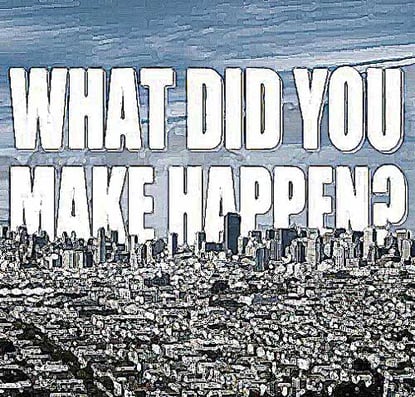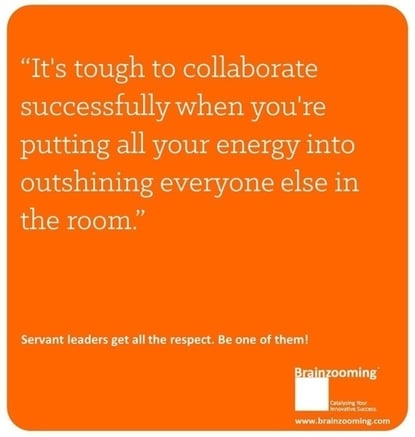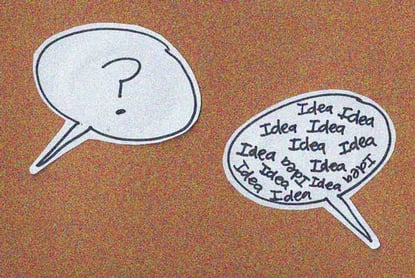Vickie Howell is a broadcast personality, producer, author, designer, and instructor in the DIY world. Her online series, The Knit Show with Vickie Howell (YouTube) is the first studio produced, community funded, internationally accessible knitting and crochet streaming series. With the help of over 1200 individual and company backers, Vickie successfully raised $83k in 30 days on Kickstarter to fund the project. As of December 2017, The Knit Show has had over a quarter of a million views in at least 19 countries.
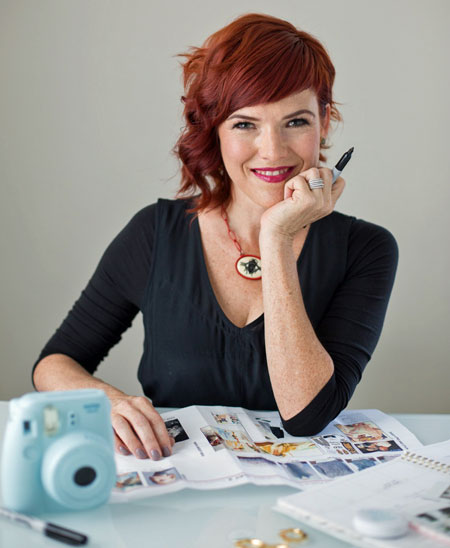 Photo: Harper Point Photography
Photo: Harper Point Photography
For the sake of transparency, I note that Vickie also played bass in the imaginary band that she and I co-founded (I was the singer; the band was called Why Barbie’s Bad) as college theater students in the mid-90s, talking our way into (and out of) any number of ridiculous situations with our over-plucked brows, dark burgundy lipstick, and matching GIRLS KICK ASS t-shirts. Later, we worked for the same film and television production company while living in the same apartment building in West Los Angeles, and briefly had a side business selling light switches lovingly decoupaged by our own hands.
Those were, as Lou Reed sang, different times.
But some things remain constant. Vickie’s drive to strategize, revise, and improvise in the name of extreme creativity and productivity is as fierce and inspiring as ever, making her a natural choice for an interview on the Brainzooming blog.
Now Streaming: Extreme Creativity and Vickie Howell
Emma Alvarez Gibson (EAG): When your show was first available on YouTube, I told Mike about it, and I didn’t think he would watch it. Because he doesn’t watch anything, really. I’m always sending him videos and stuff and he’s like, Oh...yeah...I kind of clicked on it…
Vickie Howell (VH): I mean, but it’s knitting, soooo…
EAG: Exactly!
VH: Seems like it’s a given. Of course, he’s going to watch it. No? That’s not where you were going with this?
EAG: Well, two days later, he says, By the way, I watched most of the episode! I’m like, WHAT?! He says, It was really good! I was so impressed!
VH: Why? Why did he do that?
EAG: I think it’s the fact that when you saw that the market wasn’t doing what it had been doing, you took things into your own hands and found a way to do it anyway. Without getting too precious about it, those qualities in you really kind of embody what Brainzooming is about.
So, maybe tell me about how you got to where you are now and what your thoughts are about moving forward. There was a little period when there was a ton of DIY and craft shows on and that’s where you found your niche.
VH: Do you want a little background on why that went away?
EAG: Yeah.
VH: Ad dollars. There’s no money in crafts. And basically, Home Depot and Lowes are better ad buy-ins for [networks like DIY, the home of Vickie’s first show, Knitty Gritty]. We don't have that kind of money in crafting, so it was a much more viable model to just move over to home improvement and home decorating.
DIY programming in social media has been easy. Anybody can post videos. People were getting their projects everywhere, all over the interwebs, and then they were getting the education on how to make their projects through sites like Craftsy and CreativeLive, and now Brit + Co., and Creativebug -- there’s tons of them. So, the programming industry has had to completely hustle like the rest of us. Time is ticking. Cable stations are going to turn into streaming stations. So, everybody’s going big. They’re not going to go for the “there’s no ad dollars in it” show.
I was watching this all develop over the course of about eight years. I saw it happening again and again as I was working, as I was pitching, as I was trying different things. And I was still getting these messages almost daily saying that Knitty Gritty was still impactful, still had a space in people’s lives. I wanted to recreate that essence, but for now, meaning the digital aspect, which obviously wasn’t a thing back then, and the social media aspect, which was really the most exciting part for me. I started doing Facebook Live videos the first day they were available for verified users. And I noticed how many people were watching from different countries, like Turkey, Canada, Australia, Brazil--I didn’t expect that kind of community to be out there.
And for me, now, that’s the goal today. Your community is no longer in your own neighborhood, or your own state, or even your own country. As far as you can reach, and anybody can reach that far, from the comfort of their own homes -- that reach is the limitation of your community, and community is the very base of marketing.
So, there were those two components, plus a third one. However you’re creative, whether it’s picking up a Fender Strat, or a paintbrush, or knitting needles, that is how you channel your creativity. And creativity is openness, and when you’re open, that allows you to see the world on a broader scope than what you would otherwise. I wanted to encapsulate that essence. It’s about people’s communities, it’s about connection of people, it’s about choosing it for stress reduction or for coping, or because you’re putting something beautiful out in the world, or for socialization, or whatever. So that was really important to me, and the only way that I could do that and make it look cool, without it being watered down heavily, was just to do it myself.
EAG: And from there, the wheels started turning and you started thinking, What would I need to start getting together so that I could produce this myself?
VH: Yeah. So, when I worked on a PBS show, I had co-executive produced it, and also produced it with my friend Karin Strom. We picked the guests, we picked the content, we figured it out. And so that experience gave me that final bit of confidence. And because I’d been in the entertainment industry, as you know, since I was 18 or 19, on and off, I knew a lot of it. But the actual nuts and bolts--that was sort of the final piece, just to see if I was a truly competent producer, and I found out that I was. And I loved it, and I still love it. It’s still one of my favorite things to do. That had been percolating for a couple of years. I worked for about a year’s time with Scripps [Scripps Networks Interactive], which owns the DIY Network, to license the Knitty Gritty name. It got pretty close, but we just couldn’t make it work, which was in hindsight a blessing, because I own The Knit Show, together with ProductionFor, outright. So, we don’t have to get approval for anything. It would have been nice to have that name recognition, but it’s so exciting, when I put on my marketing hat, that I don’t have the limitations that I would if I owed anything to anyone.
EAG: Absolutely.
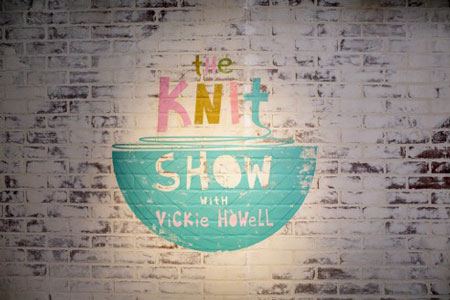 Photo: Keith Trigaci
Photo: Keith Trigaci
VH: I can work with people for sponsorships or partnerships in really interesting and innovative ways. Many companies don’t have the actual capital to invest, but they have the email newslists, or they have some kind of asset that is a viable barter, and so they get to put their name on what they think is a cool and innovative project, and we get whatever asset they have, whether it’s an e-newsblast to 250,000 people, which are eyes that we need, or it’s furniture for the set, or even wardrobe for me to wear to an appearance. And then what happens is that the backer page grows larger and larger and larger, so that when future investors look at it, they can see that a village built this. And there’s a village behind it.
So, I started building that, and then I went to my ex-husband Clint, because he owns a production company, ProductionFor. I went to him with the big piece that I didn’t know anything about, which was how to create a budget for a show. We went back and forth and I told him what amount I felt comfortable raising. As a side note, I’ve never felt comfortable asking for money. I sucked at selling Girl Scout Cookies. It’s just never been my wheelhouse. But because I could sort of see this as a service--people wanted this--I kind of worked it out. We found a number that we could at least try and raise together. We created a partnership with this company that normally produces interstitials, commercials, and the like, but really wanted to get into episodics. And I really needed a production company behind me for the technical side of it. So, we just sort of jumped in together. It was a huge learning curve, and there are a lot of lessons still being learned. But it was a pretty exciting adventure.
EAG: Once you got all the funding you needed, how quickly was the first season completed?
VH: I had my pitch meeting with ProductionFor in February. The Kickstarter began the third week in March and ended in April. I don’t know if you know this, but with Kickstarter, you get 30 days to raise all of it or you get none of it. That was the hardest thing I’ve ever done. And then I had my content producer Karin on a plane within maybe two weeks, and we started planning the grid. So, we went right into it. The actual studio production was the first week of August, it was five days and we shot ten episodes.
EAG: Where are you now in the process? What do you have happening next? If I know you there’s a long, long, long-term strategy.
VH: There is. The great thing about having streaming content is that there’s no shelf life for it. So now, I’ll go back and on a granular level, dissect it and see what I can do as far as marketing goes for external pieces. I’ve just received all the transcripts needed to get every episode captioned. Since we have 19 countries’ worth of ownership, I’d like to start experimenting with subtitles. I’m going to start with German and then probably Spanish. What I’d also like to do is investigate: can we sell this to an airline? Are there ways that we can sell pieces of it without it having to be pulled down from YouTube? And I don’t know the answer to that. So that’s something that I really want to investigate right now. And then I’ll break down each individual piece for additional cross-promotional opportunities.
We chose to put the whole season up at once to compete with other binge-worthy series in the digital market. That choice, though, means working harder to keep word circulating so new viewers find us. If I can offer screenshots and direct video links to snippets of the show that give a glimpse of even the smallest of products or locations, then I’ll ask the respective companies to feature us on social. This project is made for and by the community--so I’ll continue to ask that community to pitch in to make it a success.
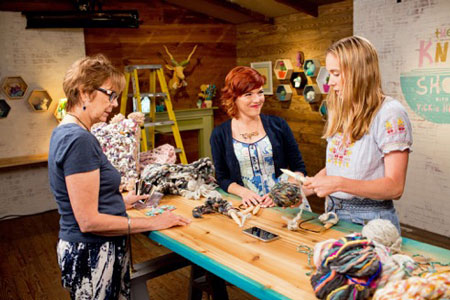 Photo: Keith Trigaci
Photo: Keith Trigaci
EAG: Blue-sky, no-holds-barred, what do you see happening?
VH: Here’s my pie in the sky: I didn’t produce this just to be a one-off. I want to continue producing the show and providing great content for the people in my community. That could be either on my own, through private investors, and just create my own thing, or it could be ultimately selling it to an Amazon or a Netflix or whatever--I think all networks are going to have streaming options soon. I have a feeling that NBC Universal will be one of the first, because they bought Craftsy, and they have Amy Poehler’s Handmade show. It could be any one of those, or it could be something I haven’t even thought of, because everything’s changing. Ultimately, I would like to produce DIY programming in all different craft realms so that I can help other designers and hosts rise. I would executive produce them. Quilting, jewelry, sewing, maybe baking, that type of thing. So that’s sort of the big picture.
EAG: A lot of people at any given point along this journey that you’ve just described would have gone, Well, I guess that’s it. What is it that keeps you pushing?
VH: I mean, but, when do you say that’s it? Like when you make your goal on Kickstarter? Or when you actually get the show produced? Or...?
EAG: I guess I’m talking more about the challenges, you know, the, Well, I have this great show, I was on this other show, but that didn’t --
VH: Oh! Because I’m totally unhireable. That’s easy. Sorry, I misunderstood the question. No, I mean, what the hell else am I going to do? I’ve always, always sparkle-fingered my way through life, you know? I’ve always talked my way in and figured it out. And I guess the fear is just having to get a regular job, maybe. And also, I’ve had some really amazing experiences of people coming up to me and sharing really powerful stories involving one of my projects. And there’s something about that that helps propel you forward when you feel like pulling the covers over your head. Knowing that even if it’s just one person, or two people, or a handful of people, that you’re making a difference in someone’s life. And, you know, I’m not curing cancer. But if I can help a mom who’s sitting in a hospital room while her baby has leukemia--this woman just told me this story last week, so it’s fresh in my mind--and my projects, columns I’ve written, whatever, helped her get through something because it gave her purpose? That’s good enough for me, man. That’s good enough for me.
EAG: Thanks, Vickie! We can’t wait to see what you do next. – Emma Alvarez Gibson
If you enjoyed this article, subscribe to the free Brainzooming blog email updates.
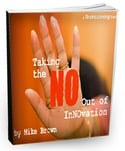 Boost Your Extreme Creativity with “Taking the NO Out of InNOvation”
Boost Your Extreme Creativity with “Taking the NO Out of InNOvation”
Download our FREE “Taking the No Out of InNOvation eBook to help generate extreme creativity and boost your creative thinking skills! For organizational innovation success, contact The Brainzooming Group to help your team be more successful by rapidly expanding strategic options and creating innovative growth strategies. Contact us at info@brainzooming.com or call us at 816-509-5320 to learn how we can deliver these benefits for you.

